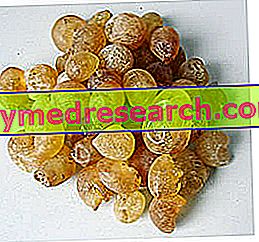What is that
Gum arabic is a natural product that oozes from the trunk and branches of some species of the genus Acacia, belonging to the family of leguminous mimosaides (in particular the Acacia Senegal - or Acacia varek - and the Acacia Seyal ). These arboreal plants, typical of sub-Saharan Africa, produce their highly prized gummy secretion following various types of stress, such as the alternation of rainy periods with others of drought, parasitic attacks and above all artificial incisions or accidental log wounds and branches. For the same reason, the secretion of gum arabic is more abundant in stunted and old plants.

Appearance and characteristics
It typically presents in the form of irregular rounded scales, with a light or amber color depending on the area of origin and the degree of purification. It is also available in the form of white, yellowish-white flakes, granules or powders, or as a spray-dried substance.
From the chemical point of view, gum arabic can be defined as a mixture of calcium, magnesium and potassium salts of arabic acid. The total hydrolysis of this particularly complex polysaccharide releases the constituent monosaccharides: L-arabinose, D-galactose, L-ramnose and D-glucuronic acid.
The field of use of gum arabic is very wide, recognizing its main applications in the food, pharmaceutical, cosmetic and paint industries.
Food additive
Depending on the food product to which it is added, gum arabic helps to prevent the crystallization of sugars, emulsifies fats, favoring their homogeneous distribution in the product, stabilizes the foam, improves spreadability and maintains aromas, humidity, flavors and color uniformity, extending the life of the product; it also reduces calories (its energy power is 50% lower than starch), and like all tires it has good satiating power.
The gum arabic does not give problems to the celiac subject, as it is gluten-free.
In the food product label, the presence of gum arabic can also be indicated by the abbreviation E414.



